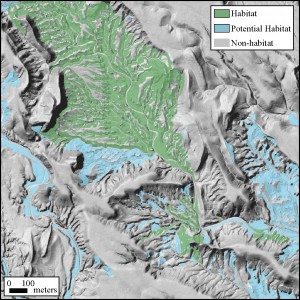 Claremont, Calif. (July 16, 2014)—In a new journal article, Pitzer College Assistant Professor of Environmental Science Colin Robins shows how subtle differences in similar-seeming habitats profoundly affect plant life. Based on more than three years of research, Robins’ paper “Establishing soil and surficial geologic habitat criteria for presumed gypsophiles — The example of Eriogonum corymbosum var. nilesii, Mojave Desert, U.S.A.” appeared in the July issue of the geological journal Catena.
Claremont, Calif. (July 16, 2014)—In a new journal article, Pitzer College Assistant Professor of Environmental Science Colin Robins shows how subtle differences in similar-seeming habitats profoundly affect plant life. Based on more than three years of research, Robins’ paper “Establishing soil and surficial geologic habitat criteria for presumed gypsophiles — The example of Eriogonum corymbosum var. nilesii, Mojave Desert, U.S.A.” appeared in the July issue of the geological journal Catena.
The paper describes the role of different soils and Earth surface processes—such as water, wind, exposure to sunlight—on the distribution of a rare shrub, the Las Vegas buckwheat, Eriogonum corymbosum var. nilesii (Polygonaceae family), in the Mojave Desert around Las Vegas, NV. The species grows only on a few gypsum-rich soils in Clark County in southern Nevada. This rare plant’s habitat is threatened by urban development, off-road vehicle use and climate change.
In their paper, Robins and co-authors Brenda J. Buck and Amanda J. Williams help explain why Las Vegas buckwheat grows in some gypsum-rich habitats but not in others that appear superficially identical. By identifying differences between inhabited and uninhabited sites that initially seem similar, they provide a refined set of habitat definitions for this species. Using GIS-based mapping, the study also demonstrates the importance and utility of detailed soil analysis and surficial geologic data for ecological research, land management and species conservation.
Robins began conducting this research on BLM land in southern Nevada in November 2009 as part of his post-doctoral research. In addition to culminating in this peer-reviewed paper, Robins’ work created opportunities for student research. In 2013, then-Pitzer student Justine Oesterle ’14 completed her two-semester Environmental Science thesis as a follow-up project to this study. Claremont McKenna College student Annika Deurlington CMC ’16 conducted a related, independent summer research project with Robins in 2013. This student fieldwork was funded in part by the W.M. Keck Science Department and Pitzer’s Institute for Global/Local Action & Study.
A professor at the W.M. Keck Science Department of Pitzer, Claremont McKenna and Scripps Colleges, Robins studies how soils, sediments and landforms record surface, climate and ecosystem histories. His current research focuses on developing quantitative, isotopic measures of arid soil minerals and applying soil science to challenges in species conservation and land management.